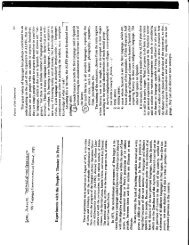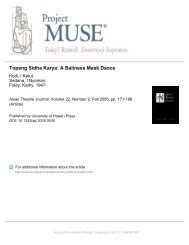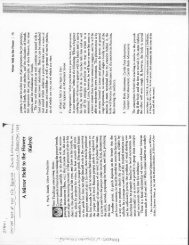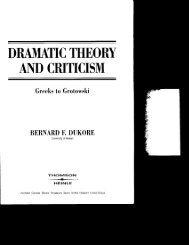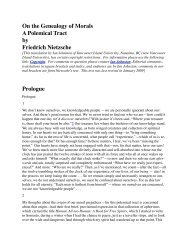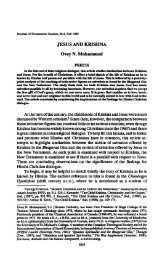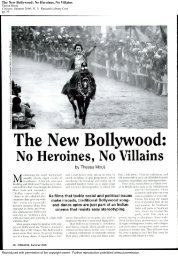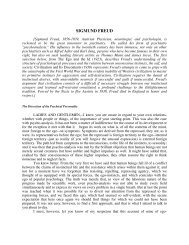Contemporary China - Yavanika
Contemporary China - Yavanika
Contemporary China - Yavanika
Create successful ePaper yourself
Turn your PDF publications into a flip-book with our unique Google optimized e-Paper software.
ith professional training.<br />
s taught by special tutors.<br />
rge of theatrical training.<br />
graduated, it set the pat-<br />
I methods follow. ln 1934<br />
rl Drama was founded by<br />
in Shandong. It ained to<br />
heatre form based on tradrawing<br />
scientifically on<br />
n required. A four-year<br />
re year devotcd to ernpiriall<br />
of these scltools were<br />
stance against Japan.<br />
rfthe actrcss in the 1920s<br />
rngstanding prejudices.<br />
:cluded from the theatre<br />
pectators during the 19th<br />
)0s one or two all-women<br />
:ijing and Shanghai. They<br />
;atherings and were not<br />
y 1920 women wcre perg<br />
theatres br,lt never along-<br />
.e 1920s Wang Yaoqing<br />
of Mei Lanfang, and Mei<br />
judices and took female<br />
wn practlce.<br />
Xue Yanqin {1906-86) and<br />
reared on the stage of the<br />
n) in Shanghai with male<br />
f eight Xue had studied<br />
techniques and kunqr in<br />
ri and later Zhang Cailin.<br />
long acting career Xue<br />
mixed casts, doing much<br />
I prestige of the actress. In<br />
hing post',vith the Beijing<br />
Xin Yanqiu studied with<br />
Yaoqing. \Vhen she began<br />
g YanqiLr, she took that<br />
onal name. Xue and Xin<br />
a galaxy of acconplished<br />
se to prominence in the<br />
rt new lustre to traditional<br />
dern theatre<br />
with a novement to create<br />
by Western exanple. The<br />
target for change. 'lhe<br />
Lrentury <strong>China</strong> resulted in<br />
many young intellcctuals being seut abroad to<br />
study. Thousands went to Japan where progressive<br />
modernization had followed the Meiji Restoration<br />
0f 1868. Japan was geographically and culturally<br />
closer to <strong>China</strong> than the West. lhe synthesis of tradition<br />
with n-rodcrnity they found tht'rc made cultural<br />
adjustment easier. lntellectuals who<br />
returned fron-r Japan bccane a major influence on<br />
the early development of nrodern Chinese theatre.<br />
ln 1907 a Chinese group rn Tokyo founded the<br />
Spring Willow Dramatic Society. Assisted by the<br />
Japanese actor Fujisawa Asajiro, who ran an acting<br />
school (see Japan, sHlNpA), they staged a version of'<br />
CamiIIe \Chahua nri) by Alexandre Dr-rnas Jils in<br />
February 1907. The play appealed to the Chinese<br />
because the heroine's plight rnirlored thc rigidify<br />
of their own narital conventions and suitably<br />
echoed their own social protest.<br />
* A five-act adaptation of Unclc Tom'.s Cobin followed<br />
inJune. Entitled lhc Black Slave's CD, to Ileaven<br />
\Heinu yutian il) it was staged at the Hongo Theatre<br />
in Tokyo where shinpo, an carly westernized<br />
Japanese genle, was fcatured. The play's acttott was<br />
expanded with extraneous interludes to please<br />
Chinese tastes. A curtain and scenery added novelty<br />
of effect. Harrict Beecher Stowc's stoly was<br />
well received fbr it offer-ed a melodramatic vehicle<br />
for protest against racial discrinination from<br />
which the Chinese too suflered.<br />
Both plodnctions used translations by Lin Shu,<br />
who first put Shakespeare into Chinese, and were<br />
performed by all-male casts. Hybrids, they nevertheless<br />
offercd a substittttc Ibr the old songdeclamation<br />
forn and the begilning of a uew<br />
genre, eventually to be named aua1u, spokcn<br />
drama.<br />
Shanghai became the centre tbr early experi<br />
ments in the new Western folm. The Spring Sutt<br />
Society under Wang Zhongshcng (d. 1911), who<br />
had studied in Japan, staged the Black Slcve's Cry to<br />
Heaven rn 1907. Lu Jingruo (1885-1915), also<br />
returned from Japan, organized the New Drana<br />
fusociation in 1912. ln 1914 Lu revived the Spling<br />
Willow Dramatic Sociefy which produced Cunilie,<br />
among other productions, in a comtneLcial<br />
theatre. Stage expertise was slight in thesc years,<br />
and old theatrc conventious lenained, inclltding<br />
female impersonation.<br />
The years 1915-19 narked a tr.rrning point. A<br />
Westerneducated generation was agitating fbr cul'<br />
tural change. lD 1916 the Aurerican-educated<br />
scholar, Hu Shi 11891-1962), spearheadcd a rnovenlent<br />
to rcplace classical language understood<br />
only by an educated elite with a standardized vernacnlar<br />
intelligible to all. New joulnals stlpportlllg<br />
thc New Culturc Movenent prolifcrated. Dranta<br />
ignored by the old literati became recognized as a<br />
mouthpiece for social reform. Neu' Ytruth, a<br />
nlnonthly cdited by Chen Duxiu \1879-1.942),<br />
devoted an issue in 1918 to Henrik Ibsen whose<br />
workwas discussed as an examplc to fbllow. In May<br />
1919 students protested in Beijing against the surrendel<br />
ofChinese sovereignty that was proposcd at<br />
the Palis Peace Conference, and whert the Treaty of<br />
Velsailles fbrmalized the proposals to <strong>China</strong>'s<br />
detriment, national outrage fbrced the Chinese<br />
government to refisc' to sigll. The new intclligentsia<br />
closed ranks in affirming an era ofdcfinitive<br />
cultural change called the Mly 4th Movement.<br />
Succeeding events broltght new impetns to<br />
change in the theatrc. ln 1921 GuJiachen fbr-rndcd<br />
the Shanghai Dranatic Association which became<br />
a fbrceful sponsor of new dratna. Two of its otttstanding<br />
members werc Ouv,tNc Yuqr,lrl and Hong<br />
Shen (1892 1955), stage director-playwrightteacher-film<br />
director. The latter studied in<br />
America fiom 1916 to 1922 and arouscd controversy<br />
ou his t'cturn by lefilsing to cotlntenance<br />
rnen playing women's roles. Endorsed by consewative<br />
public opinion, this convention remained a<br />
barrier to developing a naturalistic actilig style.<br />
Hong Shen defied lolg-standing prejudice by<br />
lecruiting actresses fiom the mole open-ninded<br />
women of the universities and the Shanghai film<br />
world.<br />
In 1921 Ouyang and Hong joined fbrces with<br />
TIAN HAN to fbund the Creatiol Society itt<br />
Shanghai. The first issue of its journal Creotton<br />
Qudrlerlv in 1922, contained Tian Han's playA Nighr<br />
at a Coffcehouse liuJei dian zhi yiye) which became an<br />
inrnrediate theatrical cuuse cilibre. The Society<br />
touled productions throughout thc countty uDtil,<br />
in 1923, it was drssolved by government order.<br />
Although it was short-lived, the Socicty was inflltcntial<br />
in introdr.rcing broad audiences to modern<br />
theatre.<br />
In the 1930s, the Japanest' military threat conlpounded<br />
by the Nationalist Communist political<br />
feud overshadowed intellectual life. Pcople in literature<br />
and the arts lesponded to a new political<br />
k



